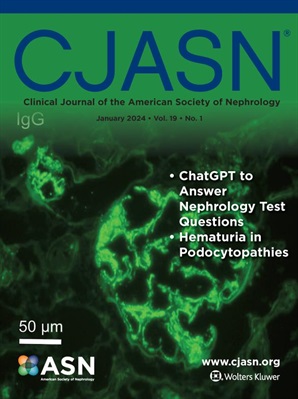Use of Aspirin and Initial Cardiovascular and Bleeding Risk in Patients with Chronic Kidney Disease
IF 8.5
1区 医学
Q1 UROLOGY & NEPHROLOGY
Clinical Journal of the American Society of Nephrology
Pub Date : 2024-11-14
DOI:10.2215/cjn.0000000619
引用次数: 0
Abstract
d the first cardiovascular and bleeding events using Korean nationwide cohort data. Methods: Among individuals aged 40–79 years with an estimated glomerular filtration rate between 15 and 59 mL/min/1.73 m2 who underwent routine health examinations between 2011 and 2016, 15,861 individuals who were newly prescribed aspirin at a dose of 100 mg/day were matched with 79,305 aspirin non-users by propensity score matching. The primary efficacy outcome was a composite of nonfatal atherosclerotic CVD or cardiovascular death. The primary safety outcome was hospitalization due to intracranial or gastrointestinal bleeding. Results: During a mean follow-up of 6.9±2.9 years, the incidence rates for the primary efficacy outcome in aspirin users and non-users were 8.0 and 9.0 per 1,000 person-years, respectively. Aspirin therapy initiation was not associated with the primary efficacy outcome (hazard ratio [HR], 0.93; 95% confidence intervals [CI], 0.86-1.04). However, the primary safety outcome of major bleeding was more frequent in aspirin users than in non-users (6.7 versus 4.7 per 1,000 person-years). The HR for this outcome in aspirin users versus non-users was 1.45 (95% CI, 1.32-1.59). Conclusions: No association was observed between aspirin use and the risk of nonfatal atherosclerotic CVD or cardiovascular death in patients with CKD stages G3 and G4 without prior CVD. Aspirin use was associated with higher risk of major bleeding. Copyright © 2024 by the American Society of Nephrology...阿司匹林的使用与慢性肾病患者最初的心血管和出血风险
利用韩国全国范围内的队列数据,分析首次心血管和出血事件的发生率。方法:在 2011 年至 2016 年期间接受常规健康检查的 40-79 岁、估计肾小球滤过率在 15 至 59 mL/min/1.73 m2 之间的人群中,15861 名新处方阿司匹林剂量为 100 mg/天的患者与 79305 名未使用阿司匹林的患者通过倾向得分匹配进行了配对。主要疗效结果是非致死性动脉粥样硬化性心血管疾病或心血管死亡的复合结果。主要安全性结果是因颅内出血或消化道出血而住院。研究结果在平均 6.9±2.9 年的随访期间,阿司匹林使用者和非使用者的主要疗效发生率分别为每千人年 8.0 例和 9.0 例。阿司匹林治疗的开始与主要疗效结果无关(危险比 [HR],0.93;95% 置信区间 [CI],0.86-1.04)。然而,阿司匹林使用者比非使用者更容易出现大出血这一主要安全性结果(每千人年6.7例对4.7例)。使用阿司匹林的患者与未使用阿司匹林的患者相比,这一结果的HR值为1.45(95% CI,1.32-1.59)。结论在未患过心血管疾病的 G3 和 G4 期慢性肾脏病患者中,未观察到使用阿司匹林与非致死性动脉粥样硬化性心血管疾病或心血管死亡风险之间存在关联。使用阿司匹林与较高的大出血风险有关。美国肾脏病学会版权所有© 2024...
本文章由计算机程序翻译,如有差异,请以英文原文为准。
求助全文
约1分钟内获得全文
求助全文
来源期刊
CiteScore
12.20
自引率
3.10%
发文量
514
审稿时长
3-6 weeks
期刊介绍:
The Clinical Journal of the American Society of Nephrology strives to establish itself as the foremost authority in communicating and influencing advances in clinical nephrology by (1) swiftly and effectively disseminating pivotal developments in clinical and translational research in nephrology, encompassing innovations in research methods and care delivery; (2) providing context for these advances in relation to future research directions and patient care; and (3) becoming a key voice on issues with potential implications for the clinical practice of nephrology, particularly within the United States. Original manuscript topics cover a range of areas, including Acid/Base and Electrolyte Disorders, Acute Kidney Injury and ICU Nephrology, Chronic Kidney Disease, Clinical Nephrology, Cystic Kidney Disease, Diabetes and the Kidney, Genetics, Geriatric and Palliative Nephrology, Glomerular and Tubulointerstitial Diseases, Hypertension, Maintenance Dialysis, Mineral Metabolism, Nephrolithiasis, and Transplantation.

 求助内容:
求助内容: 应助结果提醒方式:
应助结果提醒方式:


